equipment reviews
gitzo gt1542t — traveler series 1
In two years of using a Novoflex Quadropod as the only tripod I had many opportunities not only to appreciate its advantages but also to recognize some deficits and problems. Although the praise and the complaints that I have written in my review a year ago (see Novoflex Quadropod) remain valid, I had to conclude that the Quadropod isn't an optimal solution suitable for all situations when a photographer would want to use a tripod. When I decided to purchase a Quadropod, my goal was to have only one support with me during expeditions and trips — for all shooting situations and all kinds of subjects — for wildlife, landscapes, macro. The Quadropod concept was promising this. However, its limitations became obvious after I used it a couple of times in the field. I have written about it in the Quadropod review in detail, thus would list them here briefly:
- Even QP B — the lightest Quadropod base and the one that I have — is quite heavy.
- Assembling the Quadropod takes quite long, and a nature photographer who needs it to be immediately ready for use has to carry it assembled. With four normal, i.e. full-sized, legs a Quadropod weighs almost 4 kg and is bulky just like any large tripod.
- The light weight variant — with walking sticks — can support only very small equipment and in practice is suitable only for landscape photography, and when no wind is blowing. Shooting with a camera and lens that weigh together about 3.5 kg is not possible due to extremely high vibration. So for wildlife photography only normal legs or their combination with walking sticks can be used.
- The legs can't be fixated in open position and collapse as soon as you try to move the Quadropod at short distance. If your fingers happen to be at the base, it may be literary a pain — when they get jammed.
- There is no fixation that prevents the legs from being unscrewed off the base when you are adjusting their length, i.e. rotating the locks. For me this is the most annoying thing in Quadropod. I hope that Novoflex will find a way to improve it. Otherwise the Quadropod will be a fail.
- Unfortunately Novoflex doesn't make bases with removable centre column. Therefore, if you need a minimal height that is usually important for wildlife and macro photography, you have to choose the version QP B, i.e. the one without centre column. However, it is not that good for landscape photography where a centre column is of advantage because it allows quick and precise adjustments of view angle. With Quadropod there is no chance to have both unless you buy and carry with you two bases. As I wrote in the review, my Quadropod has a QP B base. Although I enjoyed using it with a heavy tele lens, it was very annoying when I was shooting landscapes. I even missed some shots while I was tampering with four legs of the Quadropod trying to find the proper height.
Due to such deficits of Quadropod I could not realize my plan to get along with only one support. My second goal was to have such a tripod that I would not hesitate to take with me more often. This goal wasn't possible to achieve with the Quadropod, and I noticed that I still prefer to leave this heavy gear at home whenever possible. This experience resulted in a decision to get a second support that would be an addition to Quadropod offsetting its deficits and inconveniences.
As usually in such cases, I did a careful research of small tripods currently available on the market. After many comparisons and serious considerations I finally chose this Gitzo.
construction and features
The GT1542T has the height and stability of a standard tripod, such as Gitzo Mounaineer Series 1, but is more compact when folded and much more light. It is dedicated to photographers who use professional equipment and need a highly portable support with no compromise.
The brand Gitzo is famous for high-end tripods that are utilizing some of most advanced technologies and materials. The GT1542T is one of such products. With a kit based on this tripod model the company won the "If Design Award 2012" — one prize out of 2,923 entries at one of the world’s most prestigious design competitions!
With only 1 kg, the GT1542T is currently the lightest and with less than 50 cm transport length the most compact tripod on the market that is strong and stable enough to support the weight of a professional camera body and a medium sized tele lens. The table below gives and overview of these and other important technical characteristics.
| Load capacity (with short column) | 8.0 kg |
| Material | carbon fiber 6X |
| Maximum height | 149 cm |
| Maximum height (with centre column down) | 116.5 cm |
| Minimum height | 22 cm |
| Closed length (with centre column reversed) | 42.5 cm |
| Weight | 1 kg |
| Load capacity | 8 kg |
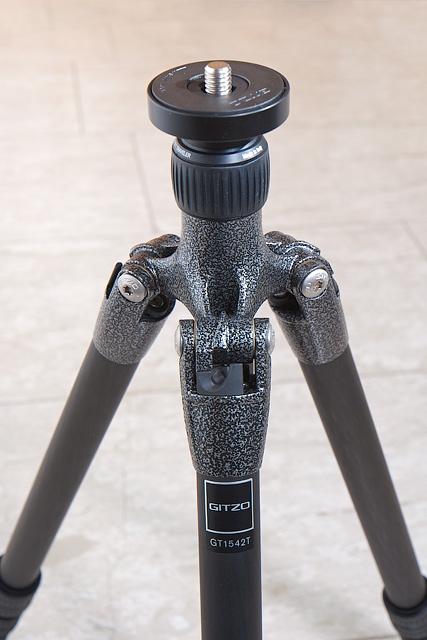
The metal parts of the GT1542T are made of magnesium and have the beautiful spotted finishing that characterizes the Gitzo tripods (see the picture on the right). The leg segments and the centre column are made of 6x carbon fibre, a material that is patented by Gitzo who claims that it makes their tripods more shake resistent and more sturdy.
The GT1542T is delivered with a long centre column. When it is completely pulled up, the total height of the tripod increases by almost 30 cm. It can be replaced by a shorter column that is available separately. The height of the centre column can be adjusted very quickly: To move it up and down you only need to loosen the fixation ring at its bottom a little. Tightening this ring immediately fixates the column. Gitzo calls this "rapid column". Nature photographers who often have to react quickly at subject's movements and scenery changes would particularly appreciate this feature. The columns in Gitzo tripods are not rotating, i.e. the horizontal rotation of the equipment is done through head. The mechanism that prevents rotation is very simple: There is a small trench along the column that fits on a rib inside the tube through which the column is moving.
The centre column can be removed completely, and the head can be mounted directly on the base. This reduces the total height even more and may increase the stability of the tripod so that it can support a heavier gear. I suppose that the claimed maximum load capacity of 8 kg can be achieved only when the column is completely down or removed. Also the minimum height of 22 cm should be possible only without the column. To remove the column you have to unscrew either the head mount at its top or the hook at its bottom. Then you can loosen the fixation screw and just pull the column out. The screw with the hook and the head mount can then be put in place of the column.
For transportation the centre column can be reversed. If the head is small, it can fit between the legs as shown on the picture below. The length of GT1542T is then below 50 cm, and it can fit even in a small equipment bag.
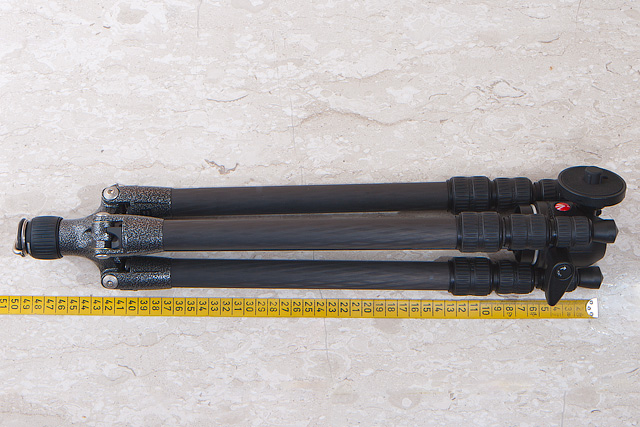
This image shows the GT1542T with a Manfrotto 486 ball head when it is folded for transportation. With such a small head, the centre column can be reversed. This reduces the length to less than 50 cm.
Since I use my GT1542T mainly for landscape photography, I have a Novoflex Magic Balance head and a panorama plate mounted on it. It doesn't fit between the legs and I don't reverse the column (see the picture below). Even then the tripod easily fits in my bag.
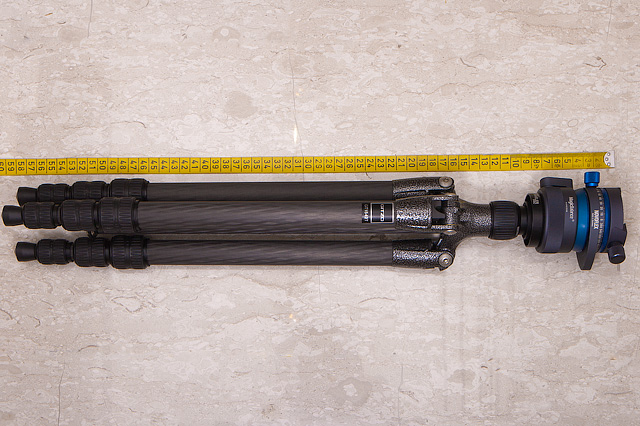
Here is my GT1542T how I use it most of the time: with a Novoflex Magic Balance leveling head and a panorama plate. This head is thicker and doesn't fit between the legs. The column can't be reversed because of that. This makes the tripod almost 10 cm longer.
The installation of GT1542T goes very quickly. You can get a collapsed tripod in position for shooting in not more than 20 seconds. When a leg is in a collapsed state, the fixation screws are so close to each other that I can loosen all three simultaneously rotating them with one hand. After that I can pull the only 1 m long leg to its full length with only one movement of my arm.
stability and shake absorption
The stability of this very small and light tripod is remarkable. However, to have an unbiased opinion, I would need another tripod of similar size and quality that I don't have at the moment. For now I only can report that I was very impressed when I tried the GT1542T for the first time. Despite its thin legs and overall slim construction it felt rock solid.
To be able to judge more objectively, I did some tests with my equipment. As usually with such tests, I was interested in real-life suitability rather than in technical aspects, i.e. I wasn't measuring anything and analyzing statistics. I used the same testing method as in my tests for Novoflex Classic Ball 5 and Quadropod review last year that allowed me to roughly assess the shake resistance of GT1542T which is the most important characteristic of a tripod.
To avoid additional damping effect of the ground I had put this tripod on a stone floor. Since the GT1542T is obviously strong enough to support a camera with wide-angle lens, I took telephoto lenses for my tests that are much more critical in terms of shakes. To simulate a heavy load, I used my EF 300 mm f/2.8 IS USM which weighs over 2.5 kg. Together with a 5D Mark II body it was well over 3 kg. For reference I took a much lighter combination of the same camera with a Sigma 150 mm macro lens. This had to simulate a normal use of this tripod. Since I was assessing only the capacity of the tripod I didn't use any head with it. Instead the lenses were mounted with their collars directly on tripod's centre column. Photographers normally use a cable or wireless, or timed release when shooting from a tripod. Personally, I use the timer release in the camera more often. So I did this time. Since the test setup with a 300 mm lens was causing pretty long shaking, I set the timer to 10s instead of my usual 2s.
All test shots were made with the same exposure settings — ISO 200, f/2.8, 1/15s — with and without live view, i.e. with and without mirror hit.
Below you see the images from test shots with a reference setup — Sigma 150mm F2,8 EX DG APO HSM and EOS 5D Mark II. Here and in all other tests below, the grey square marks the area in the frame that is showed as 100% crops in the next two pictures.
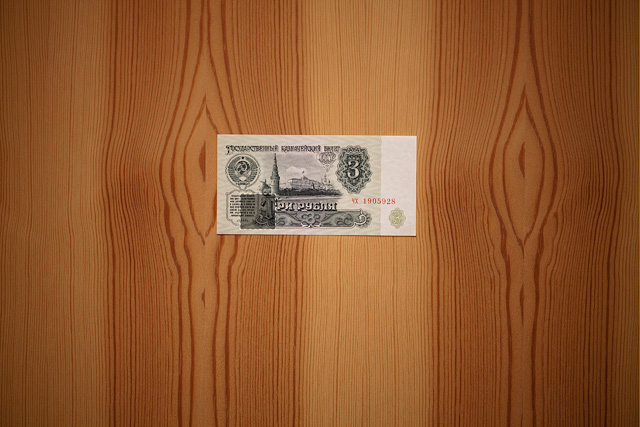 Test shot with a 150 mm lens at maximum height, i.e. with the column completely pulled up, and live view on. (The area showed below in 100% crops is marked with grey square here.)
Test shot with a 150 mm lens at maximum height, i.e. with the column completely pulled up, and live view on. (The area showed below in 100% crops is marked with grey square here.)
|
|
 150 mm — 10s timer, no mirror lockup, nor live view
150 mm — 10s timer, no mirror lockup, nor live view
|
 150 mm — live view, 10s timer.
150 mm — live view, 10s timer.
|
The first image above that shows the full frame from a shot that was done with live view turned on, i.e. when the mirror was blocked. I applied smart sharpening to this image when I was resizing it. I did this also with the next two such overview images. All 100% crops here are of course unprocessed.
As you can see in the above samples, the quality of the image is quite good — note that it was made at shutter speed of 1/15s when the column was completely pulled up. The blur caused by mirror hit is very well noticeable in the left image, however.
The next images come from the tests with a 300 mm lens. The results of the test are quite surprising. Gitzo recommends to use the GT1542T with lenses up to 200 mm only. Such lenses weigh typically not more than 1.5 kg. My 2.5 kg heavy 300 mm tele exceeds this very significantly. Also the longer the focal distance of a lens is the more prune it is to shakes. Therefore, the test setup with EF 300 mm f/2.8 IS USM was quite extreme. Nevertheless, the tripod did the job surprisingly well.
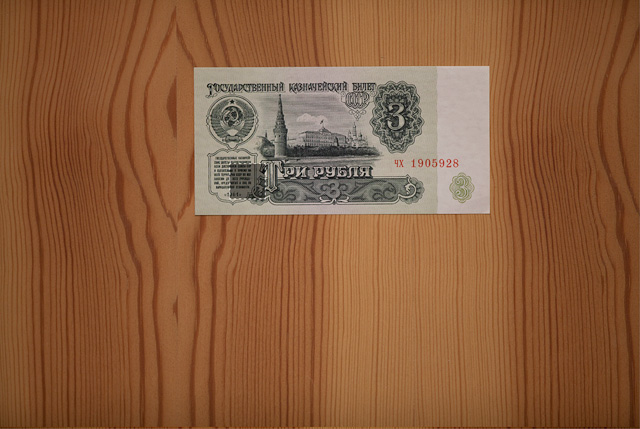 Test with a 300 mm lens with the column completely up. As in previous picture, the area of 100% crops is marked with grey square. The image showed here was made with live view on.
Test with a 300 mm lens with the column completely up. As in previous picture, the area of 100% crops is marked with grey square. The image showed here was made with live view on.
|
|
 300 mm — release button pushed with a finger.
300 mm — release button pushed with a finger.
|
 300 mm — timer release in 2s.
300 mm — timer release in 2s.
|
 300 mm — no mirror lockup, nor live view
300 mm — no mirror lockup, nor live view
|
 300 mm — 10s timer release, live view
300 mm — 10s timer release, live view
|
The first of the above 100% crops comes from an image that I shot when I just pushed the release button on the camera. You see how blurred it is. The second image was made through automatic release in 2 seconds. The equipment was still shaking. The result was less blurred but also unusable. The other two images that were made with timer set to 10s and after the shaking stopped are quite good.
My biggest surprise was to find out that pulling the column down and reducing the height brings not improvement except reduced vibration period. As you can see on the pictures below, the sharpness is similar to above images that were taken with maximum column height.
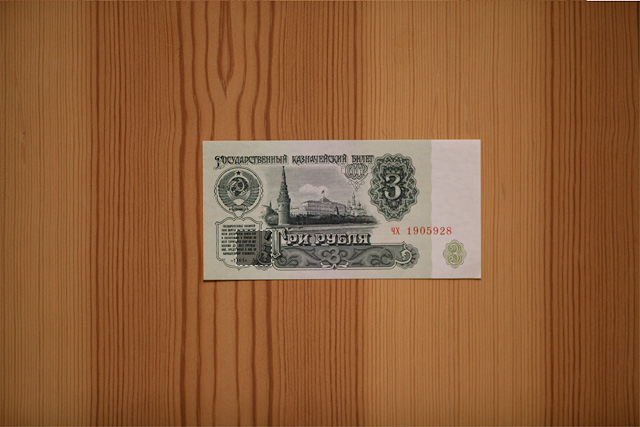 Test shot with a 300 mm lens with the column down. The area showed below in 100% crops is marked with grey square here too.
Test shot with a 300 mm lens with the column down. The area showed below in 100% crops is marked with grey square here too.
|
|
 300 mm — 10s timer, no mirror lockup, nor live view
300 mm — 10s timer, no mirror lockup, nor live view
|
 300 mm — 10s timer, live view
300 mm — 10s timer, live view
|
To test the damping capability, I used the video function in the camera. I tapped the camera with a hand and recorded the shakes on video. Below are three video clips with the results. Please compare.
|
150 mm, column up |
|
300 mm, column up |
|
300 mm, column down |
The first clip shows how the camera with a 150 mm lens shakes when the centre column is pulled up to full height. The vibration is quite insignificant and completely disappears in less than 2 seconds. A camera with a small lens can be released via a 2s timer.
With a 300 mm lens mounted, the GT1542T shakes much stronger, and much more time is necessary for shakes to settle down. Pulling the centre column completely down makes a big difference in this case: The shakes disappear almost as quickly as in tests with the 150 mm lens and the column up. The other two clips demonstrate this.
conclusions
The Gitzo Traveler Series 1 tripod, a.k.a. GT1542T is probably the best light weight tripod on the market. Of course, we will see if the tripod manufacturers would manage to create an even better traveller tripod that would meet professional requirements in the next years, but at the moment the GT1542T is absolute state of the art in terms of engineering and technical design.
My impressions of handling this tripod and the test results that I reported above in this article allow the following conclusions:
- The GT1542T is a perfect travel tripod for a serious outdoor photographer because it is extremely light weight, compact and sturdy.
- Ideally it should be used with load of up to 2.5 kg. The GT1542T performs then like much bigger tripods.
- The ability for vibration damping is very good but it can take well over 2s for GT1542T to completely absorb the shakes after you have touched the camera. Therefore a remote shutter release — via cable, IR, or radio — should be preferred with larger lenses over a delayed release with the camera timer.
- Obviously, mirror lock-up or live view have to be turned on for optimal results.
- The GT1542T can be used with longer telephoto lenses than recommended by Gitzo but only in emergency situations, i.e. when not bigger tripod is available and hand holding isn't practicable for some reason. However, it would work only if you would manage not to touch the gear during the shot and the weather would be absolutely windless. Maybe also hanging some additional weight on the hook or in a bag between the legs can improve stability, but having not tested this option, I can't confirm it.
addendum
Unfortunately, I lost the centre column in the field during my Ethiopia trip. Getting a replacement was a quite strange story that is probably worth to be told in addition to the review.
But first, I would like to confirm — now from my own field experience — the first impressions that I have written in the review above: This tripod is absolutely fantastic outdoors. It is very convenient to use and to carry, and, of course, it is very stable. I was using it for almost all landscape shots and even sometimes for wildlife. After I had lost the centre column, it was a bit too low but still useable in many situations. Only one deficit of this tripod became evident to me after I had used it for some time: Its legs aren't water and dust proof sealed. Since it isn't an electronic device nothing gets damaged due to contact with water but the tripod hast to be dried after that. Every time, after I have been using the GT1542T in water, I have disassemble it completely, clean all leg segments from inside and let them dry for at leas a day. Certainly, this is annoying and very inconvenient, particularly if you have to use the tripod every day.
Since it is a product of the “legendary” Gitzo, and even more than that — it is a current model of a popular series, I was expecting that obtaining a spare part in Germany wouldn't be a problem. After my return home, I searched the Internet for the part that I needed. To my surprise, only a so-called “short” column variant was offered by Gitzo dealers in their online shops. Also at Gitzo website no standard, i.e. long, column could be ordered. At Gitzo's site I found the address of their service partner — the only one in Germany, by the way. I sent an e-mail to that company asking for help with restoring the centre column. They responded very quickly, sending me a page from spare parts catalogue and asking to choose the part I needed and to send them its number. The centre column that I was looking for had the code D09516.24.
I mailed this code to the service. They wrote back that it would cost me €114 and that they have to order at Gitzo in Italy. Though 114 euros for 30 cm of carbon pipe was quite a lot, I agreed. They informed me that the shipment would take up to a month. (Note: The spare part had to be shipped from Italy — a neighbour of Germany whose border is only about 500 km away from my home.)
Exactly 30 days after that I received the package per post in my office. It contained a column but I recognized at once that it was too short. At home, after I assembled the tripod, it was looking as shown below. Compare this picture with the second picture on this page, and you'll see the difference.
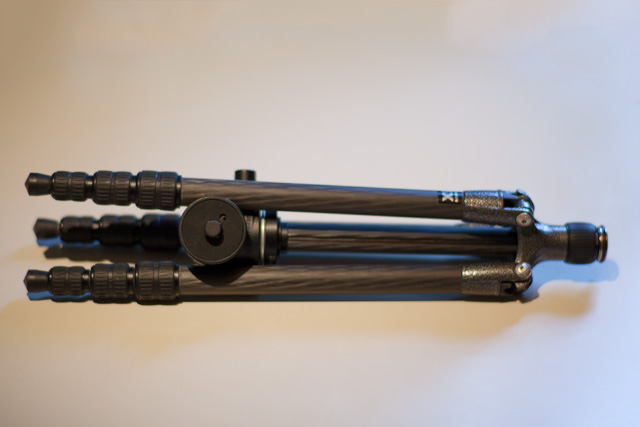
This image shows the GT1542T with the same Manfrotto 486 ball head as above, but the centre column is shorter. I got it as replacement for the lost original from Gitzo service.
The disadvantages of this column were obvious: First, the tripod was about 10 cm lower than originally; second, the head was too far between the legs when the tripod was folded for carrying, therefore it was not so compact. Strangely, the packaging of this spare part was labeled correctly, i.e. as containing a D09516.24 item. Nevertheless it was obviously a wrong part. I returned it to service company with my complains, explanations and even photos of the tripod before and after the column replacement. The service replied that they would send the item back to Italy.
Two weeks later I received another e-mail from them where they were informing me that their Italian colleagues are going to send the same wrong centre column again meaning that it was correct. I replied that I wouldn't accept it: It was clearly a much shorter column; everybody was seeing this — no matter what was written on the package. The service wrote back that they would ask Gitzo to investigate this case for possible error.
Another month was over. I sent an e-mail again to that person in the service company that I had been communicating with before asking him for an update. I got no reply. Then I sent a request to Gitzo directly via their homepage. The Manfrotto (In case you still don't know: Gitzo is actually a branch of Manfrotto.) office in Germany replied the next day. They offered me two alternatives — either to order a spare part from Gitzo in Italy and hope that it will be that time a right one, or they will send me a longer column from a Gitzo GT1830 Mountaineer model (part number D09906.24), however, made not of carbon but of basalt. Certainly I preferred the first option, i.e. to wait again till a replacement part arrives.
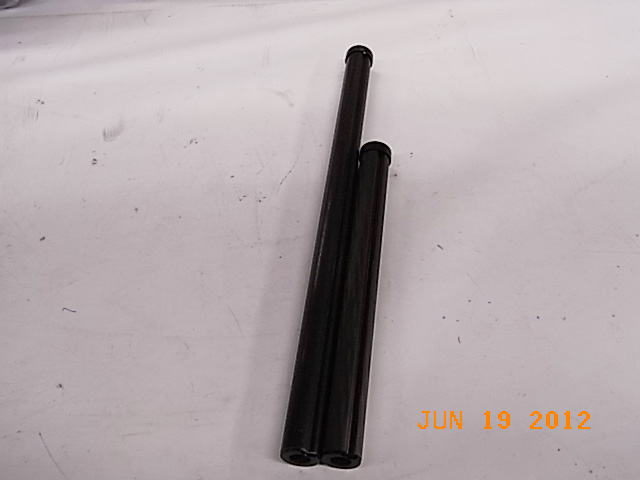
A Gitzo GT1542T centre column compared to one from Gitzo GT1830 which is compatible but much longer and made of basalt. I was afraid that using such a long basalt column may reduce the vibration damping ability of the tripod.
Three weeks later I received a mail from Manfrotto Germany telling that the centre column arrived, and that it was indeed longer. The next day it arrived per post, and recognized at once that this time the centre column was identical to the original. To my pleasant surprise, there was no invoice in the package but only a delivery note: The item was free of charge — as “fair dealing”. Although three months were necessary till the function of my tripod was restored, I was finally satisfied with Gitzo's service. Of course, it was a bit awkward for people at the headquarters that they weren't recognizing at first what was wrong with the item that they had initially shipped. However, they took my complaints seriously and finally satisfied my requests.
I also have learned from this story two things — that even small parts of an expensive gear are expensive and, even if they weren't, that it is better not to loose them because their replacement may take very long.